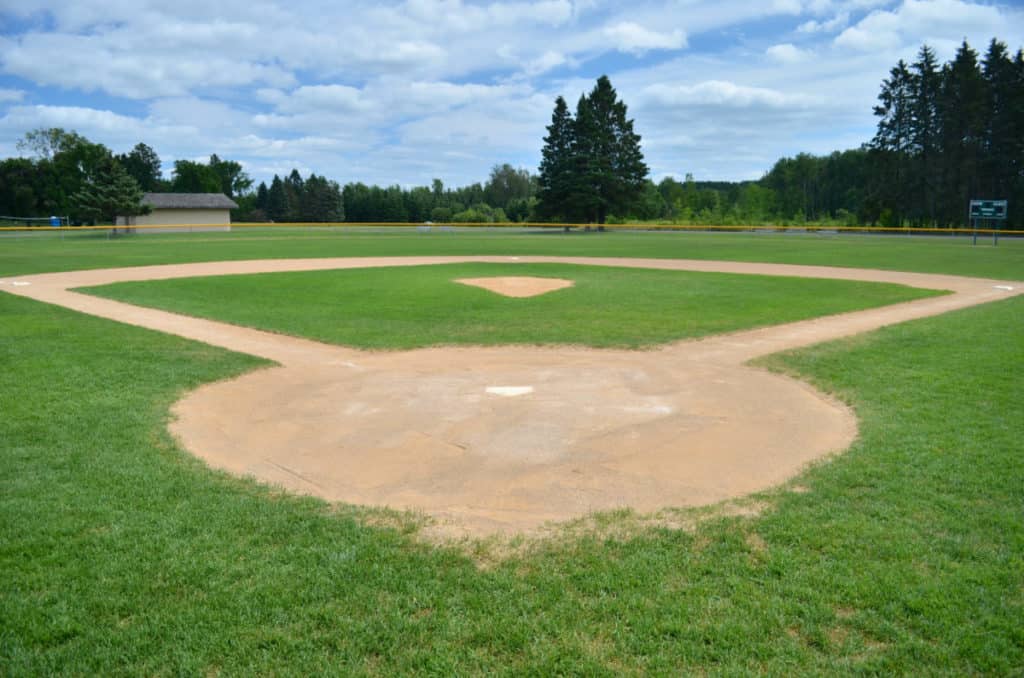While not the most demanding or important position in the field, 1st Base is important to the overall success of the team and can save certain plays by being able to dig the ball out of the dirt.
A quality 1st baseman gives the infielders the confidence needed to let the ball fly without fear or having to make a perfect throw. Field the ball and let it rip to a quality 1st baseman who can scoop the ball out of the dirt or go get it above his or her head.
There is a wide range of responsibility from fielding ground balls, getting to pop flies in foul territory, holding runners on, and serving as a cut off on balls hit to center or right field when the throw is headed to home play.
The bottom line is that to play the 1st Base position, the player must possess specific skills, overall size, and awareness for what is taking place in the game.
How To Play 1st Base
The best 1st basemen have the ability to get to a wide range of balls thrown their way as they are covering first base on a ground ball. They must also be able to catch a pop fly into foul territory and serve as a cutoff man for base hits or fly balls hit into the outfield.
Below, I will dive into the following topics related to playing 1st Base:
- Skills Required
- The Importance of the Feet and Hands
- Keys to Making Quality Throws
- Proper Positioning at 1st Base
- Drills to Improve Your Fielding Skills

How To Play 1st Base: Skills Required
We started to list some of the skills above, but here is a complete look at the list of skills required to be a quality 1st Base for your team.
- Size – It is hard to teach size, but taller players with longer arms have an advantage.
- The ability to scoop a ball out of the dirt.
- Soft hands and quick reflexes to take hard hit ground balls and get into the proper position.
- Awareness and leadership ability to help communicate with other infielders.
- The ability to field a ground ball and make a difficult throw to 2nd base for double play possibilities.
- The ability to hold a runner on, but still get to a quality fielding position.
How to decide baseball positions?
How To Play 1st Base: The Importance of the Feet and Hands
The 1st Base typically has the most range of anyone on the team. This takes quick feet, some speed and overall awareness to be in the right position to make the best play possible.
- Get comfortable in a fielding position, ready to move slightly forward on the pitch. The 1st baseman wants to be moving forward at the time of the pitch with his or her glove in front of them.
- Hands low when getting ready to field the ball, it is easier to move your hands up for a ball that bounces up. Charging a slowly hit ball and being ready will allow you to play deeper, but you must be ready to move forward.
- Feet moving and ready for action on the pitch. Think active, be active and be smart.
- Keep the bill of your hat down when fielding a ground ball, and always play the ball. Do not let the ball play you! Find a good bounce!
- Read whether the first hop is a short hop (close to the plate) or a long hop (further way from the plate) and play accordingly.
- Use a crossover step for ground balls hit to either side and stay low. Work on the backhand and planting your right foot to make a strong throw.
- On hard hit smashes, get in front of the ball and use your body. Knock it down and bare hand it to make a strong throw or underhand toss to the pitcher covering 1st base..
What is the role of the shortstop in baseball?

How To Play 1st Base: The Key to Making Quality Throws
- Many of the throws from the 1st baseman are slight underhand throws that lead the pitcher to the base. The key to this is proper footwork, moving towards the base and overall practicing this play frequently.
- A second important throw is with a runner on 1st base. The 1st baseman needs to field the ball, set his or her feet and make a strong throw to 2nd base and then potentially cover first base.
- The 1st baseman must be able to take a cutoff and make a strong throw to whatever base the catcher calls out.
What is the hardest position in baseball?
How To Play 1st Base: Proper Positioning at 1st Base
- There is no fixed position, know the hitter and the pitcher.
- When holding a runner on, work hard to get into a quality field position.
- Study the hitter and adjust throughout an at bat and during the game.
- Know the speed of the hitter. This will impact the depth you are playing at.
- Be ready for the bunt with certain hitters and certain situations.
- Field the ball and make a quality decision
- Know the condition of the field. Wet and slow. Dry and fast. Bare infield or grass infield!
How are baseball positions numbered?
How To Play 1st Base: Drills to Improve Your Fielding Skills
- Spend the most time on scooping balls out of the dirt.
- Work on your footwork around the base.
- Work on receiving the pickoff move and slapping the tag.
- Work on pop flies into foul territory. Where is the dugout or fence? Where are your other teammates. Listen and be aware.
Baseball positions in order of importance (rankings)
Things to Consider: Other Positions
Do you have the skill to play 1st Base? What is your secondary position?

Other Ideas for Improvement: Watch The Best of All Time
There have been some quality defensive first baseman that have played in Major League Baseball. Some names that come to mind that are worth checking out: Mark Grace, John Olerud, Todd Helton, Don Mattingly, Albert Pulous and Keith Hernandez. Check out how these players handled their positions: footwork, positioning, and fielding ground balls.
Final Thoughts
Whether you are a player or coach, keep the game in perspective and keep it fun. The joy of working hard, improving and competing should keep the player coming back to every practice and return to the team the following year. Enjoy the journey, embrace your teammates and celebrate the accomplishments along the way. Baseball is supposed to be fun, let’s all work to keep it that way!
